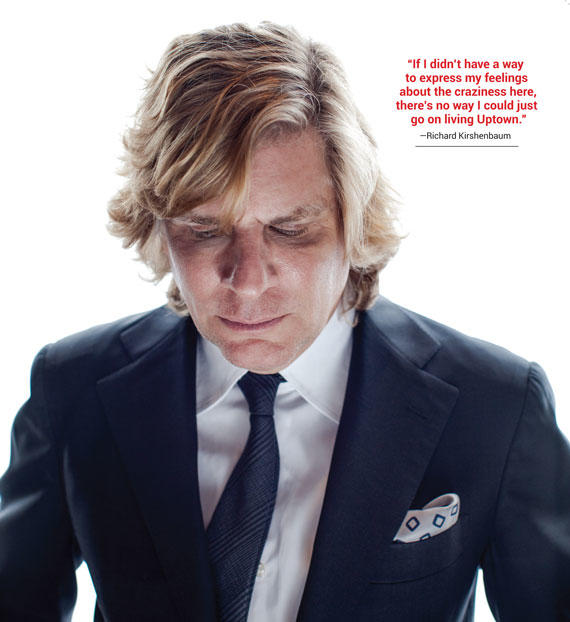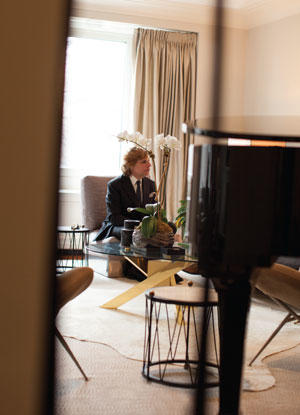Trending
Mad man mocks
Ad mogul, author Richard Kirshenbaum on skewering his own very naughty class

Advertising mogul and satirist of the super rich, Richard Kirshenbaum, 54, now finds himself under the white-hot glare of the media spotlight, dodging barbs and scooping up accolades.
With the publication of his latest book, “Isn’t That Rich? Life Among the 1%,” “Kirshenbaum,” a mouthful of a name, is seemingly on the tip of every blue-blooded tongue. The collection of stories lampoons real-life characters that haunt the co-ops of Park Avenue — when they aren’t poolside in the Hamptons or St. Barts.
There are rumors of television and movie adaptations.
He’s a “traitor to his own class,” gossip legend and frequent lunch companion Liz Smith wrote. He might be the “hottest thing since ‘Sex in the City,’” an editor at the New York Observer told Luxury Listings NYC at a June soiree in his honor at the famed Lotus Club.
More than ever, Manhattan’s one percent is finding itself in the public eye, targeted by Wednesday Martin’s new book “Primates of Park Avenue,” Bravo’s new scripted series “Odd Mom Out” and Mayor Bill de Blasio’s seemingly Robin Hood-like efforts to transfer wealth.
In a recent conversation with LLNYC that stretched from his Fifth Avenue duplex overlooking Central Park to a restaurant on Mott Street, where the rosé was flowing, Kirshenbaum said that he was inspired to write about the peculiarities of the moneyed class after witnessing a driver carry a drunken teenage boy out of a black SUV and into the lobby of “a venerable Park Avenue residential building.”
“Never mind the nannies, drivers are the new dads,” he writes.
“If I didn’t have a way to express my feelings about the craziness that goes on here, there’s no way I could just go on living Uptown,” Kirshenbaum says.
For a bit of Upper East Side “guess who,” Kirshenbaum’s given his confidants noms de guerre: the “Impossibly Blond and Glamorous Socialite,” the “Silver Fox,” “L’actrice,” the “International Playboy Posse,” the “Southern Gentleman” and the “Park Avenue Princess.” His subject matter — paid friends, bizarre diets, parents with drug habits and the finer points of donning a cashmere sweater — can sometimes be taboo. And it’s cost him socially.
“I’ve gotten a lot of blowback,” he says, recalling mean-spirited letters. “I find it interesting that sometimes people don’t understand that it is satire. People take themselves so seriously. But something that I learned in the ad business is that unless it’s controversial, it can’t be good.”
Still, Kirshenbaum said that he doesn’t judge the opulent escapades of his characters — no matter how entitled their behavior, or how deep their pockets go.
“Behaving badly and being a nice person aren’t mutually exclusive,” he says. “Some people are excess driven. That doesn’t mean they are bad people. People ask me, ‘what do you think about so-and-so spending all that money?’ I say, ‘I think it is great!’”
But there are unforgivable sins.

“The only thing that really upsets me is really bad manners. For example, let’s say you go to Cipriani and someone comes over to your table and won’t leave while you are eating dinner. That is table lingering and I hate it!”
Of course, it’s easy to sympathize with your own class. Like his subjects, Kirshenbaum eats at the city’s most glamorous restaurants (Le Cirque, Sant Ambroeus, Nobu), parties in the Hamptons, dresses lavishly and is a victim of their tax bracket.
Brooke Astor once told him, “My dear boy, every gentleman needs a club. One day you’ll appreciate it.” That’s the day he decided to join the Lotus Club, where members like Mark Twain and Tom Wolfe feted.
Amongst his set — the beautiful people who, with nonchalance, call $100 million a “hundy” — 1 percenter isn’t a bad word. It’s a membership card, an inside joke.
But unlike many of his peers, Kirshenbaum didn’t come into his money the old fashioned way – i.e. through a death in the family. Like a growing number of Upper East Side notables, he’s nouveau riche.
Growing up in the Five Towns on Long Island, he fought to expunge his working-class accent. “Long G’Island,” he used to say. Early in his career, he would eat his sack lunch on a bench along Central Park, across the street from the co-op building he now calls home.
At the J. Walter Thompson agency, he worked as a junior copywriter under best-selling author James Patterson. He was secretly taking freelance commissions on the side, against company policy.
“One day my boss came into my office and showed me an ad. He said, ‘Why can’t we do work like this?’ It was my ad,” Kirshenbaum says. “I told him, ‘I quit’ and I started my agency the next day.”
That breakthrough ad was for shoemaker Kenneth Cole. It was edgy and minimalist. Simple text on a white background, the copy read: “Imelda Marcos bought 2,700 pairs of shoes. She could’ve at least had the courtesy to buy a pair of ours — Kenneth Cole.”
“It created a sensation, because no one had done political advertising before, especially without showing the product. It was counter-intuitive,” Kirshenbaum says.
Kirshenbaum’s self-aware, postmodern copy made him the bad boy of the ad world. He helped pioneer guerilla advertising and attracted celebrities like Andy Warhol, Liza Minnelli and Joan Rivers to star in his work. (Kirshenbaum later wrote jokes for Rivers — at $6 a pop.)
When he finally sold Kirshenbaum & Bond, it was the largest independent agency in the United States, with 600 employees, three offices and close to a billion dollars in billing.
He was in his early 40s, now with substantial means. It was time to reinvent himself.
“I lived Downtown for many years, and I never ever, ever came Uptown! I felt like you needed a passport to venture past 14th Street. It was all very myopic. I didn’t really experience the city. Everyday it was apartment, work, Indochine. It felt claustrophobic,” he said. ”I thought it would be really interesting to have a different experience. So I started to look [for a home] Uptown.”

Richard Kirshenbaum in the living room of his Fifth Avenue duplex overlooking Central Park
Real estate brokers had him pegged: Downtown creative. They showed him apartment after apartment on the Upper West Side. For a while, he considered moving to the Dakota.
“In those days it was still very traditional,” he says. “People said, ‘Well, if you are going to live Uptown and you are a creative person, you should live on Central Park West.’” But light led him across the park.
“I’m obsessed with light and the Upper West Side gets the morning sun,” he says. “But Fifth Avenue light is very unusual. You get the most beautiful light around 5 or 6 p.m.“
Reflecting on his reinvented life,
he adds:
“I’m more of a fish out of water having lived Downtown versus Uptown, than coming from Long Island to the city to be honest with you,” he says, adding, “It’s a privilege to live on the park. I don’t take it for granted.”
Several weeks later, Kirshenbaum invited LLNYC to the launch party for his book at the Lotus Club. “Isn’t this so … what is it that the kids say? Meta?” one of Kirshenbaum’s creatively named subjects asks over champagne and caviar. It is clear what she means.
Waiters in blue coats hold silver trays of champagne in the grand oak-paneled library. Live jazz sets the mood, as does a torso-sized “1%” icon carved in ice. The net worth of the room’s familiar faces is well into the billions. Kirshenbaum managed to recreate a scene from his irreverent book in order to celebrate it.
Kirshenbaum sums up the moment: “It’s so important to have a sense of humor and the security not to care. I’ve always liked to stir the pot a bit.”




